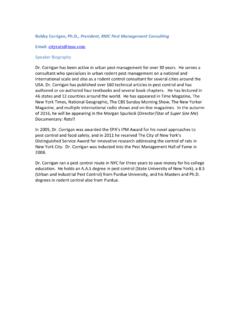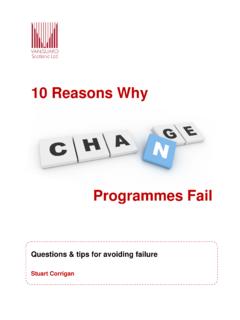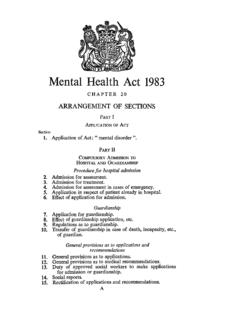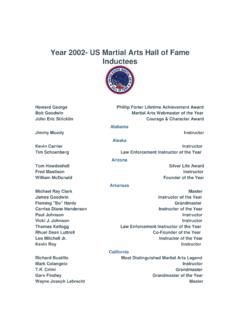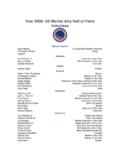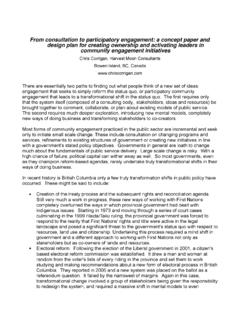Transcription of Parent-Teacher Involvement Questionnaire: Parent Version ...
1 1 Parent - teacher Involvement questionnaire : Parent Version Kindergarten /Year 1 Fast Track Project Technical Report Anne corrigan September 26, 2002 Table of Contents I. Scale Description II. Report Sample III. Scaling IV. Differences Between Groups V. Recommendations for Use VI. Item and Scale Means and SD's VII. Item and Scale Correlations Citation Instrument Conduct Problems Prevention Research Group (CPPRG). (1991). Parent teacher Involvement questionnaire : Parent Version . Available from the Fast Track Project Web site, Report corrigan , A. (2002). Parent - teacher Involvement questionnaire : Parent Version (Fast Track Project Technical Report). Available from the Fast Track Project Web site, Miller-Johnson, S. & Maumary-Gremaud, A. (1995). Parent - teacher Involvement : Parent Version (Fast Track Project Technical Report). Durham, NC: Duke University.
2 Data Sources Raw: P1F Scored: PTP1 I. Scale Description The Parent - teacher Involvement questionnaire : Parent Version is a 26-item measure developed for the Fast Track Project to assess facets of Parent and teacher Involvement . Fast Track also has a 21-item teacher Version of this measure that includes most of the items on the Parent Version . (See separate technical reports on the teacher Version for more detailed information.) The measure assesses the amount and type of contact that occurs between parents and teachers, the Parent 's interest and comfort in talking with teachers, the Parent 's satisfaction with their children's school, and the Parent 's degree of Involvement in the child s education ( , reading to them, taking them to the library, volunteering at school, attending school events). The answers are coded on a 5-point Likert scale including specific frequency ratings ( never , once or twice a year , almost every month , almost every week , more than once per week ); general impressions of frequency ( not at all , a little , some , a lot , 2 a great deal ); and level of agreement with statements about school ( strongly disagree , disagree , not sure , agree , strongly agree ).
3 A point value of zero to four is assigned to each response with zero representing no Involvement and 4 representing high Involvement . II. Report Sample This report includes data collected on Cohort 1, Year 1. The data include a high-risk control sample n=155), a normative sample (n = 387 including overlap with the control sample), and a high-risk treatment sample (n=155), for a total n = 618. Of these 618, one Washington student in the normative group is missing responses for the entire scale. In addition, nine cases three in Durham, four in Nashville, and two in Washington are missing responses for individual scale items. These students were omitted from analyses. III. Scaling Miller-Johnson and Maumary-Gremaud (1995) identified four factors within the measure and constructed corresponding subscales: Quality of the Relationship between Parent and teacher (items 11-17), Parent s Involvement and Volunteering at School (items 5-7, 9, 10, and 18-22), Parent s Endorsement of Child s School (items 23-26), and Frequency of Parent - teacher Contact (items 1-4).
4 The subscale alphas for the combined normative/high-risk sample were: .892 for Quality of teacher Relationship, .793 for Parent Involvement and Volunteering, .892 for Parent Endorsement, and .672 for Frequency of Contact. The alpha coefficient for each of the four subscales for the high-risk sample1 and normative sample are as follows: Subscale High-Risk Group Normative Group Quality of the Relationship between Parent and teacher .896 .893 Parent s Involvement and Volunteering at School .745 .815 Parent s Endorsement of Child s School .905 .885 Frequency of Parent - teacher Contact.
5 658 .658 3 IV. Differences Between Groups T-tests of means on the four subscales for the normative sample and the high-risk1 sample yielded the following results: Normative Sample High-Risk Sample Subscale Mean SD Mean SD DF t Value Pr > |t| Quality of Relationship between Parent and teacher .77 .83 615 .018 Parent s Involvement and Volunteering at School .59 .55 615 .29 .769 Parent s Endorsement of Child s School .65 .73 615 .012 Frequency of Parent - teacher Contact .81 .62 .75 615 <.0001 Results are significant (p < .05) for the Quality of the Relationship between Parent and teacher subscale, the Parent s Endorsement of Child s School subscale, and the Frequency of Parent - teacher Contact subscale.
6 T-tests for the high-risk treatment sample and the high-risk control sample yielded the following results, with no significant differences for any scale: High-Risk Treatment Sample High-Risk Control Sample Subscale Mean SD Mean SD DF t Value Pr > |t| Quality of Relationship between Parent and teacher .80 .86 308 .21 Parent s Involvement and Volunteering at School .57 .53 308 .53 .60 Parent s Endorsement of Child s School .68 .77 308 .21 Frequency of Parent - teacher Contact .81 .68 308 .38 V. Recommendations for Use Analysts should carefully consider the construct of interest for the specific analysis before using the 26-item scale.
7 Also, analysts should be aware of possible distributional issues: the teacher Relationship Quality subscale is slightly skewed in a negative direction for the high-risk1 group and the normative group. The Parent s Endorsement of Child s School subscale is slightly skewed in a negative direction for the normative group. 1 High-risk treatment and control groups combined. 4 VI. Item and Scale Means and SDs Means and Standard Deviations for Parent teacher Involvement Scale: Parent Cohort 1, Year 1, High-Risk Control Group Variable Label Mean Std Dev Minimum Maximum P1F1 Called Child's teacher 0 P1F2 Child's teacher Called You 0 P1F3 Written Child's teacher 0 P1F4 Child's teacher Has Written You 0 P1F5 Stopped to Talk to teacher 0 P1F6 Invited to School for Special Event 0 P1F7 Visited School on Special Event 0 P1F8 Invited to Attend Parent - teacher Conf.
8 0 P1F9 Attended Parent - teacher Conf. 0 P1F10 Attended PTA Meetings 0 P1F11 Feel Welcome in Child's School 0 P1F12 Enjoy Talking with Child's teacher 0 P1F13 Feel teacher Cares About Child 0 P1F14 Feel teacher Interested in Knowing You 0 P1F15 Comfortable Talking w/ teacher re Child 0 P1F16 teacher Pays Attention to Suggestions 0 P1F17 Ask Tchr. Quest'ns/Suggest'ns re Child 0 P1F18 Send Things to Class (Books, etc.) 0 P1F19 Read to Your Child 0 P1F20 Take Child to Library 0 P1F21 Play Games at Home w/ Child 0 P1F22 Volunteer at Child's School 0 P1F23 Child's School Good Place for Child P1F24 School Staff Doing Good Things for Child P1F25 Have Confidence in People at School P1F26 School is Preparing Child for Future 5 Means and Standard Deviations for Parent teacher Involvement Scale.
9 Parent Cohort 1, Year 1, High-Risk Treatment Group Variable Label Mean Std Dev Minimum Maximum P1F1 Called Child's teacher 0 P1F2 Child's teacher Called You 0 P1F3 Written Child's teacher 0 P1F4 Child's teacher Has Written You 0 P1F5 Stopped to Talk to teacher 0 P1F6 Invited to School for Special Event 0 P1F7 Visited School on Special Event 0 P1F8 Invited to Attend Parent - teacher Conf. 0 P1F9 Attended Parent - teacher Conf.
10 0 P1F10 Attended PTA Meetings 0 P1F11 Feel Welcome in Child's School 0 P1F12 Enjoy Talking with Child's teacher P1F13 Feel teacher Cares About Child 0 P1F14 Feel teacher Interested in Knowing You 0 P1F15 Comfortable Talking w/ teacher re Child 0 P1F16 teacher Pays Attention to Suggestions 0 P1F17 Ask Tchr. Quest'ns/Suggest'ns re Child 0 P1F18 Send Things to Class (Books, etc.) 0 P1F19 Read to Your Child 0 P1F20 Take Child to Library 0 P1F21 Play Games at Home w/ Child 0 P1F22 Volunteer at Child's School 0 P1F23 Child's School Good Place for Child 0 P1F24 School Staff Doing Good Things for Child P1F25 Have Confidence in People at School 0 P1F26 School is Preparing Child for Future 0 6 Means and Standard Deviations for Parent teacher Involvement Scale.

